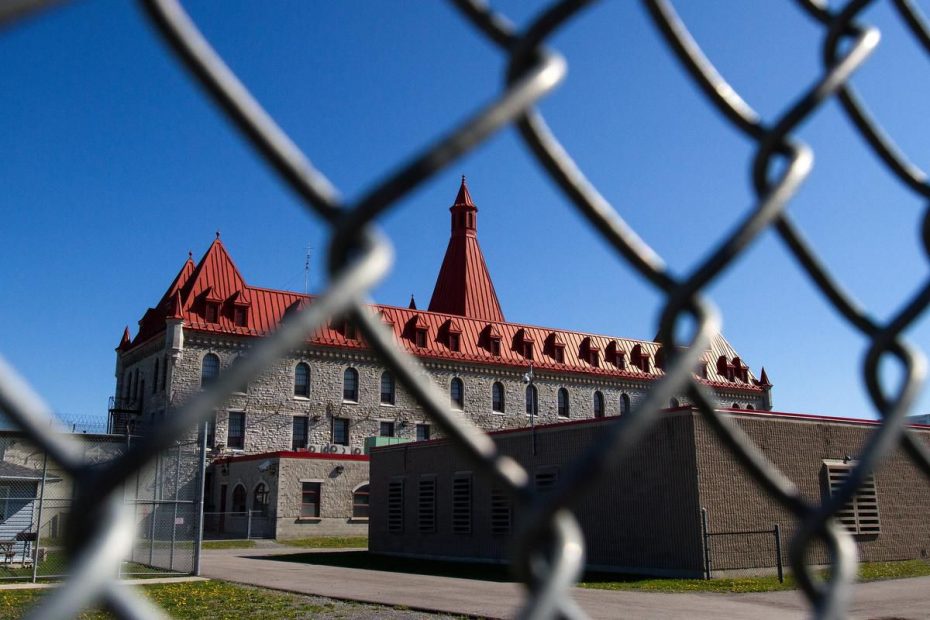It was 11:35 at night when the drone with the package marked “HITMAN” was seen hovering over the limestone walls of Collins Bay Institution in Kingston.
Such sightings aren’t uncommon. An Access to Information search by the Star found there were 27 reported incidents in 2019 of drones airlifting contraband into the four-storey prison that houses 573 minimum, medium and maximum-security male inmates.
“The drone stopped for a moment and then went vertically at a rapid pace,” a prison officer noted in a report on the Sept. 8, 2019, sighting.
The tiny aircraft silently disappeared into the night not long after that.
The next day, guards found a softball-sized package wrapped in a black women’s stocking in the recreation yard on the grass between the inmate canteen and the inmate grocery.
It contained 15 cylinders of marijuana, each small enough to be hidden in an inmate’s rectum and valuable enough in total to fetch about $45,270 on the prison black market, according to one report obtained by the Star.
In case a prisoner who wasn’t the package’s intended target got any bright ideas, it bore the label: “HITMAN.”
Red-roofed, chateau-style Collins Bay is visible from Bath Road, a major Kingston artery. For years, it’s been called “Gladiator School” by inmates because of its tough gang culture.
Years ago, previous generations of prisoners relied upon guests to smuggle them drugs, said Lorne Campbell, a former Satan’s Choice biker who was in Collins Bay in the 1980s.
“Everything was done manually,” Campbell said. “It was before the drones.”
Nowadays, drones are controlled by a joystick, smartphone or tablet. Depending on the brand, an operator can up to 10 kilometres away.
The Star’s document search found that maximum-security Millhaven Institution and minimum-security Beaver Creek reported no drone incidents in 2019.
Geography helps explain why Collins Bay was a target, said Michael Shrider of the Correctional Service of Canada.
“The institution is located in close proximity to a city centre, south of a busy street, while also backing onto fields; all certainly contributing factors to aerial accessibility,” Shrider said.
Criminal aviation enthusiasts routinely supply Collins Bay prisoners with marijuana, carfentanil, crystal meth, knives, a variety of cellphones and even a few smart watches. The demand for smart watches allows prisoners to monitor their heart-rate working out, something that didn’t surprise Campbell.
“A lot of people run in there,” Campbell said. “It’s a real exercise place.”
Sometimes, the documents state, drones swoop down in silent squadrons in broad daylight, like on July 31, 2019, when two drones were seen clearing a wall at 2:05 p.m.
Usually, drones are launched in the dead of the night, like on July 1, when a $10,000 DJI Inspire model capable of carrying a six-kilogram payload crashed shortly before 2 a.m. while hauling tobacco, marijuana, cigar leaves, two micro USB ports, two USB cords, two mini cellphones, three charging cables and four SIM cards — the institutional value of the load estimated at $18,464.
Combating the constant aerial bombardment are guards with their eyes in the sky and sniffer dogs — including ones named Elie and Roxie — with their noses on the ground.
On Aug. 20, at 10:16 a.m., one of the dogs — the name not given — sniffed out a package containing pot, tobacco and crystal meth valued at $16,617 in a routine search of the grounds.
Sniffer dog Roxie was back in action Sept. 21 after a drone so large it was described as possibly being “a very small plane flying over the institution” was spied.
For about half an hour, it circled, slowly and at low altitude, “skimming over the tower rooftops,” according to prison records.
Loading…
Loading…Loading…Loading…Loading…Loading…
“It was so low and close to the walls and towers that you could see the wings in the dark.”
This time, human authorities and Roxie came up dry, even after the yard was searched and inmates there were strip-searched.
“Nothing of interest was found,” the report states.
Marijuana that gets dropped from the skies is often packaged into two-inch cylinders that are easy to conceal.
Sometimes, they are also graded by quality, like one load containing 16 tiny cylinders — it had four different names written on all of them: “Platinum, Maui Wowwi, Gorilla Glue and Holy F—,” a report states.
Electronics are almost as popular as marijuana.
On July 30, a package was found, dangling from the razor wire atop a wall, containing a Samsung and a Google smart phone. Even without SIM cards, that drop was worth an estimated $8,000 on the prison black market. Such phones cost about $400 combined on eBay.
Shrider said authorities are studying new technologies to fight the drones.
Meanwhile, plenty of drones crash on their own. Fishing line used to dangle cargo sometimes becomes tangled in propellers.
That explains how, at 6:10 a.m. on June 7, a grey Mavic Pro drone worth about $2,000 was found in a prison dumpster. Mavic Pros are popular with fishermen, who want to get their bait far off shore, and wedding planners, who like to drop flower petals on newlyweds. This one had been carrying Zig-Zag papers, eight packages of marijuana and a charging cable. The estimated loss of the cargo was $24,210.
Guards sometimes park outside the prison walls in hopes of spotting drones.
Others perched themselves on a spot on the limestone walls with an expansive view.
Those late-night drone patrols don’t appear to be overly productive, even when the tiny aircraft are spotted. A Sept. 3 report states: “officer could see a large red flashing light above the apartment building near the Bingo Hall on Bath Road. It appeared to be part of the rooftop, however when speaking with the commissionaire he identified the red light as part of a drone that he had observed.”
“Not successful in catching the operators of the drone,” the report said.
